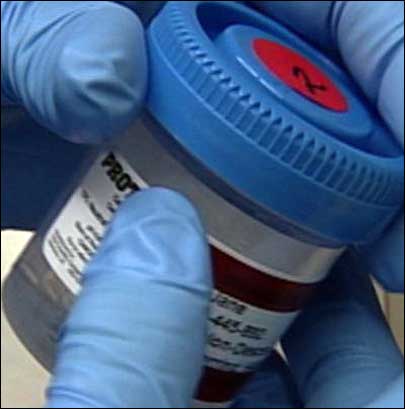Several years ago, United Hospital, in St. Paul, Minn., made headlines when it informed a patient she had breast cancer and then—two days after undergoing a double mastectomy—the woman learned she never had the disease. That mistake was due to an error in the pathology lab, where her biopsy slides and paperwork were mixed up with those of another patient.
The Mayo Clinic has had its share of specimen labeling errors as well—though, fortunately, none have resulted in tragedies—but researchers at the hospital believe they’ve found a cure: radio frequency identification. To confirm their hypothesis, the team analyzed the number of specimen-labeling errors for the first three months of 2007, prior to the adoption of RFID labels, and compared that total to the quantity of such errors for the first three months of this year, after the initiation of RFID specimen labeling.
Led by Dr. Schuyler O. Sanderson, with help from colleagues Dr. Dawn L. Francis and researcher Shalini Prabhakar, the group focused on the Mayo Clinic’s endoscopy unit and pathology lab in Rochester, which maintains three separate endoscopy practice areas comprising 41 endoscopy suites. All three practice areas utilize the same laboratory and data system.
In the summer of 2007, the researchers deployed an off-the-shelf RFID-enabled library tracking system from 3M, modified slightly to fit the requirements of the endoscopy unit and pathology lab. Passive 13.56 MHz RFID tags, complying with the ISO 18000-3 standard, are affixed to the sides of specimen bottles. After placing a specimen inside a bottle, Francis says, a nurse waves it over a pad containing an RFID interrogator, then enters into a computerized database the patient information and the instructions for that specimen. That data is correlated with the RFID tag’s unique ID number. An adhesive paper label is printed out and affixed to the side of the bottle, Francis says, and the electronic record with the RFID tag number is automatically sent to the pathology lab.
When the pathology lab receives the specimen bottles, Francis explains, they are waved over a pad with an RFID reader that captured its tag’s unique ID number. That number is then reconciled with information in the database, and the lab pulls up the electronic record associated with that particular specimen.
Prior to employing the RFID tags and database, she notes, the endoscopy unit used only paper labels affixed to the bottles. In addition to having human-readable printed text, the labels also typically contained handwritten patient information and lab instructions. But such manual procedures were prone to errors. “The RFID system has allowed the practice to step away from an old habit of adding handwriting to the printed labels,” Sanderson states. “All of that information—any that may have been added to the printed label, after the fact—is now managed by the RFID system.”
The endoscopy unit sent 8,231 specimen bottles to the pathology lab for evaluation during the first three months of 2007, and 8,539 in the first three months of 2008. The specimen-labeling errors were categorized as Class 1 (only typographical, with no potential patient-care consequences), Class 2 (minor errors, unlikely to have patient-care consequences) and Class 3 (significant errors with the potential to detrimentally impact patient care, such as a bottle with no specimen label, or one containing a label printed with information pertaining to the wrong patient).
Compared with a total of 765 errors (a rate of 9.29 errors per 100 bottles) during the 2007 evaluation, only 47 errors (an error rate of 0.55 per 100 bottles) were noted in the same period this year. In the first quarter of 2007, 646 (7.85 percent) of the errors were Class 1; 112 (1.36 percent) were Class 2; and seven (0.09 percent) were Class 3. In the first quarter of 2008, 35 (0.41 percent) were Class 1; 10 (0.12 percent) were Class 2; and two (0.02 percent) were Class 3.
“Class 2 errors are unlikely a problem, but there is the potential,” Francis says. “An example is if the specimen bottle label said ‘stomach,’ but what the nurse entered into the database was a certain part of the stomach. How that might occur is that, at the time the biopsy was taken, the nurse entered into the computer ‘stomach,’ and printed out the label, at which time the doctor said the biopsies were taken from the stomach. Then the doctor later might be more specific and say the biopsies are from the antrum of stomach, and while the nurse made the change in the computer, a new label wasn’t printed out.”
Regarding the two Class 3 errors found in the first quarter of 2008, workers caught the mistakes in both instances and used the RFID system to rectify them.
Francis says she and her colleagues weren’t surprised with the study’s findings. “We certainly were pleased,” she says. “We had to do something that eliminates human error, and [RFID] was our best option. RFID offers a redundancy mechanism.”
The endoscopy unit is still employing the RFID system, and has deployed as many as 30,000 RFID bottles to date. Although implementing RFID specimen bottles at other Mayo Clinic hospitals and departments will add costs (the outpatient endoscopy unit alone processes more than 30,000 specimen bottles annually that are sent for pathologic review), Francis says the benefits of using RFID outweigh the expense. Patient safety is the number one goal, she adds, and reducing errors certainly helps to achieve that goal—but RFID also helps lower costs.
Using a paper-based manual system had required the clinic’s lab staff to spend approximately 3.5 minutes per case to identify and rectify errors, which adds up to about one-half of a full-time lab technician’s annual work hours. When the unit switched to the RFID system, Francis says, “there was such a huge reduction of errors, and that saves time. We could eliminate the cost of half a person’s lab salary.”
The researchers’ findings were presented at the 2008 American College of Gastroenterology (ACG) Annual Meeting, held Oct. 3-8, in Orlando, Fla.
The two-phased study followed an RFID pilot in 2006, in which the Rochester Mayo Clinic employed the same passive RFID tags from 3M to track patients’ gastrointestinal tissue specimens (see At Mayo Clinic, RFID Tracks Biopsies). According to Sanderson, that project was a limited deployment of the RFID system within the endoscopy practice.
“We had installed the system in only five endoscopy suites, and in the laboratory,” he explains. “The major difference between the two studies is the extent of the system installation and the volume experienced. The new study allowed for the transition from the conventional paper-based requisition form that accompanied all specimens to a paperless system supported by the RFID system. The migration to a paperless requisition system has allowed the practice to appreciate the efficiencies associated with such, and to see a dramatic improvement in our labeling discrepancies. The full deployment also allowed for the realization of specimen tracking for three separate practice locations within Rochester to gain view of in-process delivery.”




